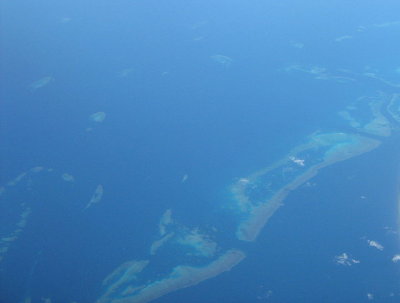![]() The Pacific War Online Encyclopedia
The Pacific War Online Encyclopedia
|
| Previous: Reed, John W. | Table of Contents | Next: Rees, Thomas W. |

Wikipedia.
Cropped by author
A reef is an area of dangerously low water (6 fathoms = 11m or less
at high tide) that is located far
enough from dry land that its
presence is not obvious under conditions of low visibility. Reefs are a
hazard to navigation and, when located off a beach, can seriously
restrict access to the beach.
Of particular significance to the Pacific War were coral reefs.
These are large masses of limestone produced by colonies of coral, a
primitive form of animal life that lives attached to the reef and
filters plankton from seawater. Coral thrives in very warm, shallow,
clear water, and coral reefs are thus common just offshore of tropical
islands. Atolls are a particular
form of tropical island formed almost entirely of debris from coral
reefs that has been piled up by the action of wind and waves.
Because coral cannot tolerate polluted or fresh water, coral reefs
do not form where rivers or streams enter the ocean. This often means
that navigable channels, called passes, form in an otherwise solid reef
surrounding an island. When an island is eroded to sea level, as in the
case of an atoll, the pass usually remains, marking where a river once
existed.
The Solomon Islands and
New Guinea are almost everywhere
surrounded
by reefs, which were generally very poorly charted at the time war
broke out in the Pacific. Neither the Japanese
nor the Allies were eager
to risk major warships
in the maze of reefs to the north and east of eastern New Guinea, which
explains why almost no significant naval engagements took place here
during the South Pacific campaign. By contrast, the waters around the
Solomons rapidly deepen offshore. Reefs are only found close to land,
where they are less of a hazard to navigation, and numerous naval
engagments were fought here.
Reefs were also an obstacle to amphibious assault. The Tarawa invasion nearly ended in disaster when unexpectedly low tides left so little water over the offshore reef that landing craft were unable to cross and the troops were forced to wade hundreds of meters to shore. Later landing operations either landed where there was a sand beach unprotected by a reef, employed reef-crossing landing craft such as the LVT, or employed underwater demolition teams to destroy the reef with explosives.
Coral itself proved to be a surprisingly good construction material. Besides
being abundant in many locations, crushed coral formed a hard, durable
surface when rolled and wetted down, its chief weakness being that it
became rather dusty when dry. This could be overcome either by
frequently rewetting the coral or by oiling the coral surface. Bulk coral is actually stronger than concrete or ordinary limestone and was used extensively by the Japanese in field works.
References
"Handbook on Japanese Military Forces" (1944-9-15)
The Pacific War Online Encyclopedia © 2009-2010, 2014 by Kent G. Budge. Index